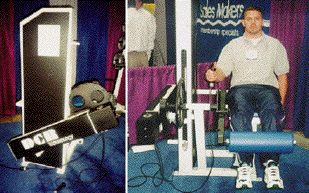A NEW WEIGHTS MACHINE WITH DYNAMICALLY ADJUSTABLE RESISTANCE Frederick C Hatfield PhD International Sports Sciences Association, Santa Barbara, California 93101. Email: drsquat@issaonline.com Sportscience 3(1), sportsci.org/jour/9901/fch.html, 1999 (762 words) Reviewed
by: William J Kraemer PhD, Human Performance Laboratory, Ball State
University, Muncie, Indiana 47306; Steven S Plisk, MS CSCS, Director of
Sports Conditioning, Yale University, New Haven, Connecticut 06520
|
|
Those of you who, like me, have spent nearly 50 years in theweight room will recall all manner of equipment that promised torevolutionize training. In my opinion only a small handful ofinnovative devices have been introduced, and most of those during thelast two or three years. Whether they have improved the effectivenessof strength training is often hotly debated. The new machine I reviewhere may be one of the good ones. For years, strength-training machines were built with no specialintent beyond making muscles bigger and stronger by allowing the userto work against resistance. Then a few of the more thoughtfulathletes and trainers realized that the ability of a muscle torapidly generate maximum force involves a time/rate dependency thattheir current training technology was unable to address adequately.An explosion of innovations ensued. Eventually four categories ofdevice could be discerned (Hatfield et al.,1999):
Most sport scientists agree that machines are generally inferiorto the constant resistance provided by free weights. Nevertheless,derivative technologies continue to flood the marketplace. Recently,Scott Naidus has patented and produced a cam-operated selectorized(weight-stack) machine (Figure 1).
The machine has an electric motor that drives two sprocketsengaged by a cam designed to increase or decrease the angle of motionof a weighted lever arm. This innovation allows the user to adjustthe resistance at any instant during a movement. The inventor usesthe term dynamically controlled resistance (DCR) to describethe way the machine works (see his commercial site www.dcrtech.com).Naidus claims the following unique benefits for his machine:
Let's look at this technology from the standpoint of current gympractice. One training method in particular comes to mind: forcedreps. An experienced and educated spotter can be helpful in ensuringthat the lifter is working at the highest level of stress simply byadding to or taking away some of the weight in the lifter's hands.But such gifted spotters are rare. With the new machine, a lifter canalter the amount of resistance at any time, thereby accounting formomentary fatigue or a sticking point in a given movement. As usual,the chief drawback is the level of training wisdom of the lifter inknowing when to alter the resistance, and by how much. In a personal communication to me, Naidus wrote: I believe the features of my machines are excellent for permitting the exerciser to engage in different and unique routines in every workout, thereby serving to stimulate the muscles and impose upon them new patterns of workloads. This should ultimately result in constant adaptation, and better strength gains. I do not disagree. This, from an old gym rat: it's certainly wortha try! Just don't throw away your dumbbells and barbells. Hatfield FC, KreisEJ, Hatfield II FC (1999). Sports conditioning: the complete guide.Santa Barbara, California: International Sports SciencesAssociation Reviewers'Comments Stephen Plisk pointed out that the machine is a modified versionof those designed to exercise muscle groups in isolation. He assertedthat such exercises are non-functional. The author thought thisassessment was "a bit harsh", because they "work fine at producingoverload". The reviewer also downplayed the importance of "time understress". He emphasized the importance of "impulse and motor control"in the development of strength, and he thought that "this type ofresistance-training technology does little to account for them". Inreply, the author agreed with the need to lift weights more slowly atfirst, and that the importance of motor control is why "...we alllike free weights more than machines.." William Kraemer was a little more positive than Stephen Plisk, buthe raised several issues. I quote with minor editing:
The author thought that this response was fair. He agreed thatonly time will tell whether the new tech is better than what has gonebefore. I also gave Scott Naidus an opportunity to respond to thisarticle. He said
that it was not his intention to replace freeweights with his machines. His
objective is to give athletes anothertool to maximize performance. ©1999 |
